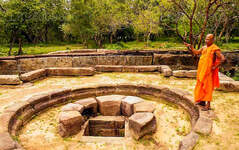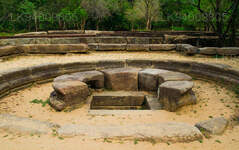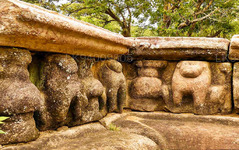
Ampara City
Ampara: District in Sri Lanka's Eastern Province, showcasing diverse landscapes, wildlife sanctuaries, historical sites, and cultural attractions, perfect for exploration and adventure.
Magul Maha Viharaya
History and legends
The history of Magul Maha Vihara possibly dates back to the period of King Kavantissa (205-161 BC) who ruled the Kingdom of Ruhuna in ancient Sri Lanka. There are evidence that suggests that the king has built this temple in the 2nd Century BC on the exact location where he married the princesses Viharamahadevi, the daughter of king Kelani Tissa. Other sources claim that King Dhatusena (463-479 AD) built this temple while many other monarchs renovated it through the centuries later. There is a stone inscription at the site of this temple that dates back to the 14th century which supports the latter view.
According to legend Viharamaha Devi, the daughter of King Kelanitissa volunteered to sacrifice herself to the sea to appease the gods who were enraged at the King for punishing an innocent monk. The princess was safely carried over the ocean waves, reaching ashore at a place near the Muhudu Maha Viharaya in Pottuvil, where the encounter between king Kavantissa and the princess took place which later led to their marriage. The legend also tells that the marriage ceremony was conducted at the premises of Magul Maha Viharaya in Lahugala, where the King had later built the temple to celebrate the auspicious event. The foundations of the Magul Maduwa where the wedding ceremony took place can still be seen at the temple premises. Magul is a word in native Sinhala language which gives the meaning wedding or auspicious.
Magul Maha Vihara had been renovated by several monarchs after its establishment. A 14th century stone inscription, located within the temple premises, reveals about a queen who also had the name Viharamaha Devi, wife of King Buvenekabahu IV of Gampola and Parakramabahu V of Gampola, who renovated and donated many acres of land to this temple. Magul Maha Viharaya is inscribed in this stone inscription as Ruhunu Maha Viharaya. Some other sources reveals that king Dappula I (661-664 AD), constructed this temple after listening to the preachings of Buddhist monks. It is speculated that around 12,000 monks inhabited the complex at some stage in history, which is evident to the largeness of the ancient temple.
Ruins and surroundings
Presently a significant amount of ruins of the ancient temple can be seen at the location. The image shrine, the Bodhi Tree (sacred fig) and the stupa are all in a good state of preservation. The main gate, a solidly built wall that surrounds all the buildings and the remains of a small shrine with an unusual moonstone at its entrance are some of the structures that can be seen at the site today. The elephants on this moonstone all have riders on their backs, something unseen in all other Sri Lankan moonstones. The stupa of Lahugala Magul Maha Vihara is built on a high terrace with three staircases leading up to it. There are images of grand lion guardians at the top of these stairs.
The causeway which is used to approach Magul Maha Vihara is situated across a lotus filled reservoir which surrounds the entire temple complex. The entire temple complex had covered an extent of around 10,000 acres where ruins of a palace, moonstone, monastery, bo-maluwa, stupas, ponds etc. are found scattered all over. These and all the other ruins at Lahugala are all surrounded by the forests of the Lahugala National Park, which is an important habitat for animals such as elephants, sambars, deers, leopards and many endemic birds of Sri Lanka.
About Ampara District
Ampara is belongs to the Eastern Province. of Sri Lanka It is a remote city on the East Coast of Sri Lanka, about 360 km from the capital city of Colombo.Ampara is the largest paddy harvesting province in the country, and has the Indian Ocean on the east coast of Sri Lanka as a fisheries resource. Most of the civilians are Sinhala, while Tamils and Moors also live in the coastal parts of the district.
About Eastern Province
The Eastern Province is one of the 9 provinces of Sri Lanka. The provinces have existed since the 19th century but they didn't have any legal status until 1987 when the 13th Amendment to the 1978 Constitution of Sri Lanka established provincial councils. Between 1988 and 2006 the province was temporarily merged with the Northern Provincee to form the North-East Province. The capital of the province is Trincomalee. The Eastern province's population was 1,460,939 in 2007. The province is the most diverse in Sri Lanka, both ethnically and religiously.
Eastern province has an area of 9,996 square kilometers (3,859.5 sq mi).The province is surrounded by the Northern Province to the north, the Bay of Bengal to the east, the Southern Province to the south, and the Uva, Central and North Central provinces to the west. The province's coast is dominated by lagoons, the largest being Batticaloa lagoon, Kokkilai lagoon, Upaar Lagoon and Ullackalie Lagoon.










